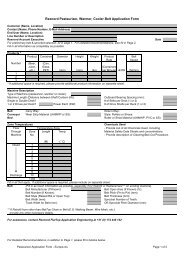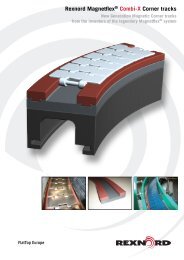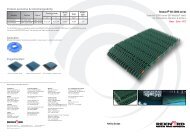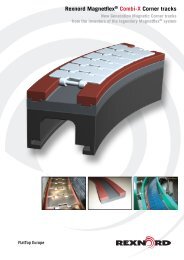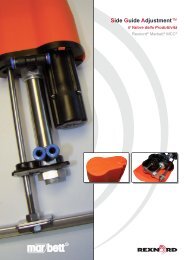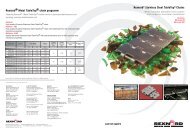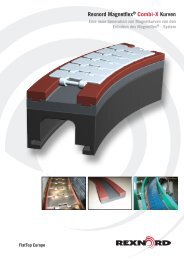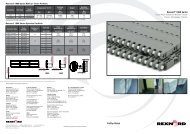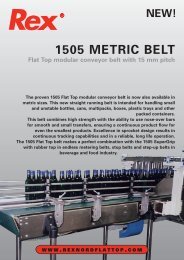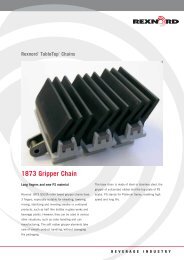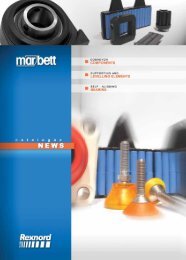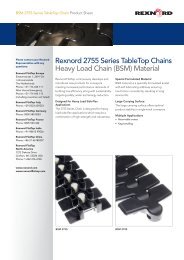Rexnord ® Run Dry - Rexnord FlatTop Europe
Rexnord ® Run Dry - Rexnord FlatTop Europe
Rexnord ® Run Dry - Rexnord FlatTop Europe
You also want an ePaper? Increase the reach of your titles
YUMPU automatically turns print PDFs into web optimized ePapers that Google loves.
<strong>Rexnord</strong> ®<br />
<strong>Run</strong> <strong>Dry</strong>...<br />
Get the FACTS first
In many industries, conveyors have been running dry successfully for over<br />
20 years using <strong>Rexnord</strong> superior materials such as the patented XL and<br />
LF acetal-based materials and, more recently, HP and PS ® acetal-based<br />
materials.<br />
However, you need to get the FACTS first from...<br />
<strong>Rexnord</strong> ®<br />
<strong>Run</strong> <strong>Dry</strong> is not an all-or-not<br />
Application Engineers from <strong>Rexnord</strong> <strong>FlatTop</strong> can help you to determine<br />
where it’s practical and cost effective to run conveyors dry and where<br />
it may be best to run with water, a dry lubricant or water and soap<br />
lubrication. Our experience has shown that a significant portion of the<br />
conveyors in bottling and packaging plants can either be converted to run<br />
with dry lube, run completely dry, or to run with a dramatic reduction in<br />
water and soap consumption.<br />
<strong>Run</strong>ning dry is not only a chain issue.<br />
Many other factors need to be taken into<br />
consideration; such as:<br />
•<br />
•<br />
•<br />
Conveyor cleanliness<br />
Container stability<br />
Increased component wear<br />
NEW PHOTOS IN • THIS Hard water deposits<br />
LOCATION!<br />
•<br />
Chemical compatibility of cleaners<br />
and lubricants<br />
•<br />
•<br />
Product damage<br />
Conveyor pulsation<br />
• Horsepower draw on motors and energy<br />
consumption
Functions of lubrication<br />
•<br />
•<br />
•<br />
•<br />
•<br />
•<br />
•<br />
•<br />
•<br />
Reduce friction<br />
Allow relatively instable containers to slide<br />
Extend wear life of chains and components<br />
Reduce energy consumption<br />
Keep friction at a constant level<br />
Wash away debris<br />
Clean conveyor systems<br />
Reduce noise<br />
Dissipate static charge<br />
hing proposition<br />
Advantages NEW PHOTOS and IN THIS disadvantages of lubrication alternatives:<br />
LOCATION!<br />
Conditions: <strong>Run</strong> <strong>Dry</strong> Water Water and Soap <strong>Dry</strong> Lubricant<br />
Reduces chain wear<br />
Enhances product stability<br />
Reduces energy consumption<br />
Acts as a rinse (i.e. spilled product)<br />
Reduces bacteria growth<br />
Resists hardness scale build-up<br />
Does not leave deposits (i.e. limescale, etc.)<br />
Does not need drip trays<br />
Does not need distribution systems<br />
Prevents static electricity build-up<br />
Prevents chain dust issues<br />
Not effective Somewhat effective Effective<br />
Very effective<br />
Extremely effective
Benefits of water and<br />
soap lubricant<br />
<strong>Run</strong>ning conveyors with plain water, with a dry lubricant or no lubricant at all seems like<br />
a good idea since it saves the cost of soap and/or lubricants. However, there are many<br />
things to review before making the decision to turn off the traditional method of water and<br />
soap lubrication. The benefits for running conveyors with water and soap are:<br />
•<br />
Flushes debris or spilled product away continuously.<br />
With water and soap lubrication conveyors are<br />
kept relatively clean<br />
•<br />
Provides a lower friction, helping to minimize product<br />
damage due to backline pressure<br />
•<br />
•<br />
Helps reduce bacterial growth on conveyors<br />
Minimizes or eliminates hard water deposits, such<br />
as calcium<br />
•<br />
Helps wash off the residual chemicals that are left<br />
on the chain after routine cleaning procedures<br />
• Reduces load requirements for motors and drives<br />
Benefits of run dry<br />
There are many benefits of running dry as follows:<br />
•<br />
•<br />
<strong>Dry</strong> floors for improved safety<br />
Reduced corrosion on equipment, bearings, motors and<br />
floor areas<br />
•<br />
No slime or soap scum build up on or under the<br />
conveyors improving cleanliness<br />
•<br />
•<br />
•<br />
No need for drip trays<br />
Reduced sanitation frequency due to bacteria problems<br />
No false rejection from bottle inspector due to<br />
foam on bottom<br />
•<br />
No soap residue in labelers or packers causing package<br />
damage<br />
RUN DRY - <strong>Rexnord</strong> ® has helped plants to run dry for over 20 years<br />
with superior, patented materials such as LF, XL, HP & PS ®<br />
•<br />
•<br />
•<br />
•<br />
•<br />
No wet lubricant carry-over onto trays and foils<br />
No mold growth and more stable pallets<br />
No need for bacteriostatic and additives in waste water<br />
system<br />
Water consumption is reduced or eliminated<br />
Environment friendly
WATER AND SOAP LUBRICATION<br />
offers many benefits such as:<br />
keeping the conveyor clean,<br />
providing lower friction, helping to<br />
minimize bacterial grown, reducing<br />
hard water deposits and diluting<br />
harmful chemicals<br />
Benefits of dry lubricant<br />
A dry lubricant system has many of the same benefits of a run dry conveyor, but, with the added benefit of a lower<br />
coefficient of friction. A dry lubricant is applied with an automatic system with dosing units that put very little lubricant on<br />
select areas of the conveyors. The lubricant can be water or oil based, with teflon, silicone or solid micro-particles. The<br />
preferred lubricant is an oil and water emulsion. The most critical part is how the lubricant is applied on the chain; this is<br />
typically accomplished with the use of brushes, shoes or spray nozzles. The benefit of spray nozzles is no contact with<br />
the chain eliminating trapped dirt or debris. The lubricant can also be applied to the inside of a curve for side-flexing<br />
conveyors. There are many dry lubricant products on the market which have been specifically formulated for either plastic<br />
or metal chains and container types.<br />
Some systems using <strong>Rexnord</strong> ® plastic chains with a<br />
dry lubrication use as little as 10 liters of lubricant per<br />
line, per year!<br />
The success of using a dry lubricant depends on many<br />
factors such as:<br />
•<br />
•<br />
•<br />
•<br />
•<br />
•<br />
•<br />
•<br />
•<br />
•<br />
•<br />
•<br />
Container stability<br />
Friction between chain and container<br />
Speed<br />
Layout<br />
Electro-static charge<br />
Wear life of the chain<br />
Wear resistance of the chain<br />
<strong>Dry</strong>-in of cleaning agent<br />
Product damage<br />
Reduced limescale deposits<br />
Product spillage<br />
Wear surface lubrication<br />
DRY LUBRICANT offers many benefits such reduced water consumption,<br />
impoved safety, and clean products into the labelers or packers
Conveyor Cleanliness<br />
Non-lubricated conveyors must be cleaned<br />
<strong>Rexnord</strong> ®<br />
Considerations for run dry conveyors<br />
periodically to prevent spills and debris<br />
from increasing friction. Part of the reason<br />
conveyors require the use of soap today is<br />
to help keep conveyors clean. The <strong>Rexnord</strong> ®<br />
patented superior materials such as LF, XL,<br />
HP and PS ® resins can be cleaned easily.<br />
WATER AND SOAP LUBRICANTS offer a continuous cleaning<br />
process. Conveyor cleanliness considerations must be taken<br />
into account when planning on reducing or eliminating water and<br />
soap lubrication<br />
Container Stability<br />
When lubrication is not an option, the customer must review the stability of the product<br />
conveyed on the conveyors. <strong>Rexnord</strong> has developed a formula to calculate the critical friction<br />
coefficient.<br />
Critical Friction Coefficient (F C<br />
): F C<br />
= R/HS<br />
R = Radius of the container base<br />
HS = Height of the center of gravity<br />
HT = Height of the container<br />
F W<br />
= Friction between chain and wearstrip<br />
If F C<br />
> F W<br />
the application is considered stable<br />
If F C<br />
< F W<br />
the application is considered unstable STABLE<br />
UNSTABLE<br />
For Petaloid bottles: R becomes R 1<br />
Under perfect conditions the decision to run PET without lubrication depends on bottle<br />
stability and friction of the chain. A general rule of thumb to follow is:<br />
If F C<br />
< 0.17 lubrication is necessary<br />
If F C<br />
> 0.25 dry run is possible<br />
If F C<br />
is between 0.17 and 0.25 run dry is only possible under strict conditions<br />
Conveyor Pulsation<br />
Under certain conditions, long or slow running conveyors may pulsate. With reduced lubrication,<br />
this condition may increase and could cause product tippage. Pulsation can be reduced by<br />
selecting chain and wearstrips with the lowest coefficient of friction or reducing the length of the<br />
conveyor.
Product Damage<br />
Plastic or aluminum containers dent or damage easily from contact with other<br />
containers or conveyor guiderails. Containers may scuff as they move along the conveyor<br />
line. A conveyor chain may run satisfactorily without lubrication, but the real issue is<br />
whether the containers will maintain their attractive appearance when backline pressure<br />
increases after lubrication is reduced or eliminated. Controlled product flow is also a<br />
consideration - integrated controls and drives can improve performance and extend<br />
component life by reducing the amount of container accumulation.<br />
PRODUCT DAMAGE<br />
such as scuffing can occur without<br />
proper review<br />
Increased Chain Wear Due to Hard Water<br />
Before running conveyors with only water lubrication, <strong>Rexnord</strong> ® recommends measuring water hardness to assess<br />
potential chain wear performance. Water always contains minerals such as calcium or magnesium, and the higher the<br />
concentration, the harder the water is. Excessively hard water causes scaling, which is the precipitation of minerals that<br />
form hard deposits (also called limescale). Limescale is caused by water evaporating and leaving behind the mineral<br />
deposits. This limescale can decrease the life of the chain and other wear components such as sprockets and wearstrips.<br />
The limescale deposits will build up around the link and the pin and will become the main abrasive component for the<br />
chain, thus accelerating joint wear and chain elongation! Sprocket teeth wear can also be expected due to the limescale<br />
abrasion. Increased sliding friction may mean more frequent component replacement. Be certain to take this into<br />
consideration. If water is used as a lubricant, wear due to hard water deposits could be a<br />
concern (with run dry or dry lubricant lines this is not an issue).<br />
Water hardness measures the total concentration of Ca (Calcium) and Mg (Magnesium)<br />
and can be controlled by the addition of chemicals and by large-scale softening with<br />
zeolite resins. Water softeners are also called ion exchange units and the pros and cons<br />
Pros:<br />
•<br />
•<br />
•<br />
Cons:<br />
•<br />
•<br />
Relatively inexpensive<br />
Removes ions from water prior to being sprayed on the chain<br />
If water is efficiently recycled, recharging of the softening tank will be required<br />
very infrequently<br />
Additional salt in the wash water could cause secondary issues at the plant<br />
or with the groundwater<br />
Softening tank will need occasional maintenance to add a salt block for cleaning<br />
EVIDENCE OF HARD WATER<br />
can often be seen by the limescale<br />
deposits on the sides of the<br />
conveyors and components<br />
•<br />
The resin is not an inexhaustible exchange site; it will have to be run on an alternative backwash cycle<br />
•<br />
Water treatments can be obtained from lubricant suppliers to provide an alternative to<br />
water softeners. The use of chelating agents that can be added to the lubrication water for<br />
prevention of hard water deposits (see <strong>Rexnord</strong> Hard Water Recommendations for more<br />
detailed information).<br />
INCREASED COMPONENT WEAR<br />
such as joint wear or elongation<br />
can be a result of water scale
<strong>Rexnord</strong> ®<br />
Considerations for run dry conveyors<br />
Compatibility of Cleaners and Lubricants<br />
When conveyors are cleaned (oftentimes with strong alkaline or oxidizing chemicals), the residual<br />
chemicals are left on the chains. With water and soap, the chain is being continuously rinsed. By<br />
eliminating water and soap there is no longer this additional rinse and the cleaning chemicals will<br />
have more contact time with the chain - potentially even drying and concentrating to a point where<br />
they destroy the chain through chemical attack. It is strongly suggested that prior to removing<br />
water and soap or changing to a dry lubricant customers need to reevaluate their cleaning<br />
chemicals, concentrations, cleaning frequency and rinse time to find a way to sanitize the system<br />
regularly without being detrimental to the chain performance.<br />
General guidelines for cleaning solutions are:<br />
1. Recommend pH of 4-10. Strong caustic agents should not be used with plastic chains NEW PHOT<br />
2. Avoid chlorine (bleach), ammonia or iodine<br />
LOCATION<br />
3. With plastic chains, avoid phosphoric acid (found in many stainless steel cleaners)<br />
4. Refer to the corrosion resistance guide in the Engineering Manual (8rxEM-en) to determine<br />
the compatibility of cleaners used on chain and other conveyor components<br />
It is extremely critical to ALWAYS thoroughly rinse all cleaning agents completely off of the chain<br />
and conveyor frame. Make sure that the underside of the chain is also rinsed thoroughly. Failure<br />
to follow the chemical compatibility guidelines and this caution note could result in chain damage<br />
and/or failure due to chemical attack.<br />
All cleaners and lubricants must be<br />
compatible with the chain, wearstrips and<br />
sprocket materials (see item 4 above). It<br />
is critical to have an integrated cleaning<br />
and lubricant approach for the success<br />
of any process. If there are compatibility<br />
issues or concerns, contact Application<br />
Engineering or your cleaner and/or<br />
lubricant manufacturer for assistance. It<br />
is recommended to ask the manufacturers<br />
for cleaner recommendations that are<br />
compatible with the specific lubricant.<br />
CLEANING CAUTION NOTES:<br />
1. Keep water, steam and chemicals away from electrical disconnects, motors, photo eyes, etc.<br />
2. It is recommended that steam not be held on chains for prolonged periods. Chains may deform or become<br />
permanently damaged.<br />
3. Before working inside conveyor frames or coming in contact with conveyor components, always make sure<br />
all drives are locked out and tagged.<br />
4. If conveyors are going to sit idle for long periods of time before start up, they should be covered with plastic<br />
or drop cloth to minimize dirt and debris that can settle into chains and tracks.<br />
5. Before start up, remove any tools, fasteners, or other items that may have been left behind. Thoroughly<br />
clean chain, wearstrips, and tracks with air hose or high pressure water spray.
General Cleaning<br />
Recommendations<br />
Dirty and sticky chain or conveyors can cause increased<br />
container backline pressure and damaged containers.<br />
Without the continual cleaning action of water and soap<br />
lubrication, dirt, debris and spilled product (such as syrup,<br />
OS IN THIS<br />
beer, soda, etc.) may build up on the chain and in the conveyors.<br />
! This can result in increased wear of the chain, wearstrips,<br />
sprockets return rollers and corner tracks and severely increase<br />
friction. Therefore a thorough and regular cleaning procedure<br />
s one of the critical success factors of any dry run conveyor.<br />
It is critical to clean the entire conveyor system when changing from one process to another. This cleaning should be done to eliminate<br />
slime, bacteria, etc. that can be found within the conveyor. In addition it is recommended to review and revise cleaning practices when<br />
changing from one process to another. Not following or lack of proper cleaning SOP’s (Standard Operating Procedures) comprises<br />
success .<br />
<strong>Rexnord</strong> ®<br />
Extending Chain Life<br />
Recommended Cleaning Frequency<br />
• Completely <strong>Dry</strong> Lines - These lines should be washed down daily to obtain maximum sanitation and<br />
performance. At the very minimum, rinse daily and thoroughly sanitize weekly.<br />
• Partially Lubricated Lines (Water or <strong>Dry</strong> Lubrication) - Thoroughly sanitize these lines weekly.<br />
Methods of Cleaning<br />
1. Periodic high pressure water rinse should prove satisfactory. Spray the chain in place on each conveyor, both on the carry and in<br />
the return sections. This is usually done with the conveyors running. For easy access to the undersides of the chains in the carry<br />
and return ways, some manufacturers provide “clean-out” holes in the side frames.<br />
2. Warm water and mild soap are commonly used to clean the conveyors<br />
3. Foaming agents or other chemical cleaners may be used if they are compatible with the conveyor materials. Carefully follow the<br />
instructions provided by the manufacturer to determine proper concentration of solutions and proper, safe use and disposal.<br />
4. Some PET bottle conveyor cleaners or combination “cleaner/lubrications” are applied continuously or intermittently. Several types<br />
of automatic application systems are available.<br />
5. In extreme situations, it may be necessary to periodically clean the chains with a brush. Clean the chain in place on the<br />
conveyor, both on the carry and in the return sections.
<strong>Rexnord</strong> ®<br />
<strong>Run</strong> <strong>Dry</strong> with Confidence<br />
<strong>Run</strong> <strong>Dry</strong> with Confidence<br />
Don’t wait to find out what running dry means to your operation. Application Engineers from <strong>Rexnord</strong>’s<br />
<strong>FlatTop</strong> Division can help you to determine where it’s practical and cost effective to run conveyor lines dry and<br />
where it may be best to lubricate.<br />
Start with the facts...<strong>Rexnord</strong> can help to perform a comprehensive survey of the conveyor lines in your plant,<br />
including layout, length, width, speed, motor horsepower and other details. This data will be analyzed and<br />
compiled into an easy to use format so that you can clearly see the limits of each parameter for running dry.<br />
The four important criteria are:<br />
•<br />
•<br />
•<br />
•<br />
Percent of allowable chain tension<br />
Percent of existing horsepower<br />
Percent of allowable PV limits<br />
Product backline pressure<br />
Based on the data collected, recommendations can be given on which conveyors can run dry or which<br />
may need some form of lubrication. <strong>Run</strong>ning dry is seldom an all-or-nothing proposition as in the following<br />
success stories.
1982....<br />
Engineered Materials<br />
LF and XL Material - The world’s Aligned original with long life Trends and low friction<br />
chain material<br />
1993....<br />
HP Material - The world’s first high speed and run dry chain<br />
material<br />
2005....<br />
PS ® Material - The world’s fastest running and longest wearing<br />
chain material<br />
Today....<br />
<strong>Dry</strong> running application expertise made available from years of<br />
field experience<br />
Platinum Series ® Success Story<br />
High Speed Filler Discharge Conveyor<br />
A major soft drink manufacturer installed <strong>Rexnord</strong> PS (Platinum<br />
Series) chain as an upgrade for a high speed PET bottle conveyor.<br />
The PS chain required far less lubrication to operate at the same<br />
level as the previous HP (High Performance) chain. After 90 days<br />
of running with the PS chain, the Plant Manager stated that the filler<br />
discharge conveyor was using 2/3 less lubrication per shift. The<br />
plant monitored the motor amperage draw as a means of testing the<br />
friction levels in the conveyor system. The final result was that the<br />
PS material could operate at high speeds with far less lubrication<br />
than HP in the same application. The amperage remained the same<br />
and slightly dropped over a 90 day period. The chain is running<br />
successfully since 2005 showing how <strong>Rexnord</strong>’s superior materials<br />
can help to decrease or eliminate lubrication requirements.<br />
<strong>Dry</strong> Lubricant Success Story<br />
<strong>Dry</strong> Lubricant Reduced Bottler’s Annual Water Consumption by 675,000 Gallons (2,558,925 Liters)<br />
A large carbonated soft drink bottler was running well but they wanted to convey bottles without using<br />
lubricant dilution water. A leading dry lubricant manufacturer applied a new chemistry that is “neat” and<br />
requires no lube dilution water. The dry lubricant was dispensed with traditional spray nozzles using a<br />
touch-free application technology. Improvements were seen in both lubricity and bottle mobility, leading<br />
to operational gains. Removing the media for microbiological growth meant cleaner nozzles, conveyors,<br />
and drip pans. Production workers at the plant enjoyed the dry enviroronment and the safer, water-free<br />
floors. The plant saw hard dollar savings in the cost of water, softener, and effluent treatment. The water<br />
Renxord Fortrex 9200 Series<br />
cost for the plant per thousand gallons (3,791 liters) (in/out) was $6.31.<br />
MatTop<br />
By<br />
Chain<br />
removing<br />
easy-to-assemble<br />
the lubricant dilution<br />
water the plant reduced water consumption by 675,000 gallons (2,558,925 modules liters) make and maintenance saved $4,260 easy annually.<br />
Additional savings on softener treatment and effluent treatment totaled and $970. cost effective The total gross hard dollar<br />
savings realized by the plant was $5,230 on an annual basis.
World Class Customer Service<br />
For more than 100 years, the dedicated people of <strong>Rexnord</strong><br />
have delivered excellence in quality and service to our<br />
customers around the globe. <strong>Rexnord</strong> is a trusted name when<br />
it comes to providing skillfully engineered products that<br />
improve productivity and efficiency for industrial applications<br />
worldwide. We are committed to exceeding customer<br />
expectations in every area of our business: product design,<br />
application engineering, operations, and customer service.<br />
Because of our customer focus, we are able to thoroughly<br />
understand the needs of your business and have the resources<br />
available to work closely with you to reduce maintenance<br />
costs, eliminate redundant inventories and prevent equipment<br />
down time.<br />
<strong>Rexnord</strong> represents the most comprehensive portfolio of power<br />
transmission and conveying components in the world with the<br />
brands you know and trust.<br />
<strong>Rexnord</strong>, TableTop, MatTop Platinum Series and PS are registered trademarks, and HP is a trademark of <strong>Rexnord</strong> Industries, LLC. All rights reserved.<br />
WORLDWIDE CUSTOMER SERVICE<br />
AUSTRALIA<br />
<strong>Rexnord</strong> Australia Pty Ltd<br />
Picton, New South Wales<br />
Phone: 61-2-4677-3811<br />
Fax: 61-2-4677-3812<br />
BRAZIL<br />
<strong>Rexnord</strong> Correntes Ltda.<br />
Sao Leopoldo - RS<br />
Phone: 55-51-3579-8022<br />
Fax: 55-51-3579-8029<br />
CANADA<br />
<strong>Rexnord</strong> Canada Ltd.<br />
Scarborough, Ontario<br />
Phone: 1-416-297-6868<br />
Fax: 1-416-297-6873<br />
CHINA<br />
<strong>Rexnord</strong> Conveyor Products<br />
(Wuxi) Co. Ltd.<br />
Shanghai<br />
Phone: 86-21-62701942<br />
Fax: 86-21-627019433<br />
FLATTOP EUROPE<br />
<strong>Rexnord</strong> <strong>FlatTop</strong> <strong>Europe</strong> b.v.<br />
‘s-Gravenzande, The Netherlands<br />
Phone: 31-174-445-111<br />
Fax: 31-174-445-222<br />
After Hours/Emergency Phone:<br />
31-174-445-112<br />
<strong>Rexnord</strong> Marbett®, S.r.l<br />
Correggio (RE), Italy<br />
Phone: 39-0522-639333<br />
Fax: 39-0522-637778<br />
RMCC Deutschland Kette GmbH<br />
Aßlar-Werdorf, Germany<br />
Phone: 49-6443-83140<br />
Fax: 49-6443-831420<br />
<strong>Rexnord</strong> <strong>FlatTop</strong> France<br />
Orly Cedex<br />
Phone: 33-1-4173-4220<br />
Fax: 33-1-4173-4229<br />
MEXICO<br />
<strong>Rexnord</strong> <strong>FlatTop</strong><br />
Toll-Free Phone: 001-888-808-7787<br />
Fax: 1-262-376-4720<br />
UNITED STATES<br />
Customer Service<br />
Phone: 1-866-REXNORD<br />
(1-866-739-6673)<br />
Fax: 1-614-675-1898<br />
E-mail: rexnordcs(state)@rexnord.com<br />
Example: rexnordcsohio@rexnord.com<br />
<strong>Rexnord</strong> <strong>FlatTop</strong> North America<br />
Grafton, Wisconsin<br />
Phone: 1-262-376-4700<br />
Fax: 1-262-376-4720<br />
<strong>Rexnord</strong> International - Power Transmission<br />
Milwaukee, Wisconsin<br />
Phone: 1-414-643-2366<br />
Fax: 1-414-643-3222<br />
international2@rexnord.com<br />
ALL COUNTRIES NOT LISTED<br />
<strong>Rexnord</strong> <strong>FlatTop</strong> <strong>Europe</strong> b.v.<br />
‘s-Gravenzande, The Netherlands<br />
Phone: 31-174-445-111<br />
Fax: 31-174-445-222<br />
After Hours/Emergency Phone:<br />
31-174-445-112<br />
<strong>Rexnord</strong> <strong>FlatTop</strong> <strong>Europe</strong> b.v. flattopeurope@rexnord.com www.rexnordflattop.com<br />
<strong>Rexnord</strong> <strong>FlatTop</strong> North America 1272 Dakota Drive Grafton, WI 53024 www.rexnord.com<br />
© 2008 <strong>Rexnord</strong> Industries, LLC<br />
8rxRUNDRYpb-en 02/09 Delzer Litho Printed in USA



